|
|
EARLY AUTUMN EDITION | SEPTEMBER 2022

|
|
Introducing Program Manager

As most readers know, long-time Oregon Urban and Community Forestry Assistance Program staff, Katie Lompa and Kristin Ramstad have retired. Kristin is currently working part-time for the program to help with transition details until the new program team is up to speed.
In mid-June, Scott Altenhoff joined ODF to lead the Urban & Community Forestry Assistance Program. For the last 17 years, Scott has been working with the City of Eugene as a municipal arborist/urban forester. Prior to that, he worked for 13 years as a commercial arborist and forestry contractor throughout the Pacific Northwest. In the late 2000s, Scott taught courses in Beginning and Advanced Arboriculture at Linn-Benton Community College. Scott has a longstanding passion for helping people to better understand and appreciate trees and forests, especially when it involves climbing trees and helping folks to experience the magic of the forest canopy. While working at the City of Eugene, Scott was heavily involved in strategic planning, capacity building, community outreach and engagement, and process improvement that centered on equity, sustainability, and resilience.
Scott is excited to join the ODF U&CF Program and apply his skills/knowledge to help expand upon all the great work that has been accomplished by ODF U&CF Program staff over the last three decades. Some specific areas that he hopes to focus on include strengthening the statewide urban forestry network and workforce, improving urban wood and woody biomass utilization, promoting climate smart urban forest management, and advancing community resilience and wellbeing through green infrastructure. Scott currently serves as the Immediate Past President of the Society of Municipal Arborists (SMA) and as Co-Chair on the Board of Directors for Canopy Watch International. In his free time, Scott enjoys international travel, exploring remote natural areas, and spending time with his wife and his daughter. If you don’t already know Scott, please reach out to introduce yourself, he’d really enjoy connecting with you.
|
We are looking for a NEW Community Assistance Forester!
With Katie Lompa’s well-earned retirement, the Oregon Urban and Community Forestry Assistance Program is recruiting for a full time Community Assistance Forester. The position will be based in Salem and will likely require a lot of traveling around Oregon, mostly in daytrips (originating in Salem), but with some overnights required. A hybrid work schedule may be negotiated after the initial six months of employment. The successful candidate should be an ISA-certified arborist, have experience with TreePlotter™ Inventory, have experience working in urban forestry, stellar communication skills, and be willing to meet in-person with city staff. Knowledge of emerald ash borer response and the Arbor Day recognition programs and/or newsletter production are desirable qualifications. Deadline for applications is Sept. 19.
Emerald ash borer in Oregon – What should cities do now?
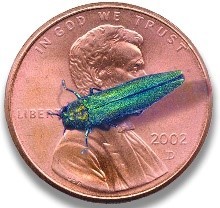
Many of you have probably heard the news that emerald ash borer (EAB) has been found in Forest Grove. Some of you may be thinking, ‘Why are people making such a big deal about this little insect?”
EAB kills ash trees. Due to their tall, graceful stature and lovely fall color, non-native ashes are popular urban in parks, along streets, and in back yards. Oregon also has a native species of ash (Fraxinus latifolia) that plays an important ecological role along streams and riverbanks.
Whether in towns or along rivers, losing our ash trees will result in economic hardship for many cities, and an ecological disaster for the fish and wildlife that depend on them. EAB has swept through the Midwest and East Coast causing billions of dollars of damage. No state has been able to eradicate this pest or stop it from gradually spreading.
The Oregon Dept. of Agriculture (ODA) and Oregon Dept. of Forestry (ODF) have been preparing for this insect for several years and have a plan in place. However, their efforts to limit EAB’s spread depend on an informed populace (you!).
First – Don’t Move Firewood. According to ODA and ODF experts, “the natural (unaided by humans) dispersal rate of adult emerald ash borers depends on variable factors such as winds, insect population density and availability of ash trees. Adults naturally disperse anywhere from about half a mile to over six miles a year. However, a small percentage of the strongest fliers have traveled up to 12 miles. Of course, if transported in firewood these beetles can be carried hundreds of miles in a single journey.”
Second, identify the locations of your city’s ash trees. ODF has free tree inventory software available to cities to help with this. Take note of where your largest most beautiful ashes are systemic injections of emamectin benzoate are widely considered by experts to be the most reliable, cost-effective, and ecologically-friendly type of chemical treatment for EAB. The Oregon Dept. of Agriculture regulates pesticide use in Oregon and has an approved list of chemical treatments on their website. It's important to note that, even if approved, chemical treatments are not appropriate for all situations or for saving all trees.
|
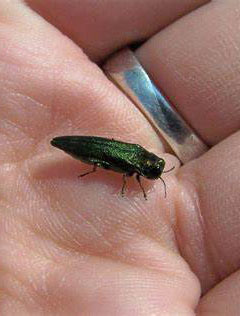
Photo: An adult emerald ash borer is very small. If you find a small green beetle in your ash trees, please report it so that it can be officially verified by experts. Credit: Creative Commons.
Next, evaluate your ash trees. Notice those trees with few or no leaves in their upper canopy, or a “tufty” appearance of leaves. These may be symptoms of drought or other factors, but it can also be an indicator of EAB infestation. While you are looking, check for tiny “D-shaped” holes about 1/8 inch wide, any evidence of woodpecker-dug holes, and tiny flying metallic green beetles about ½ inch long and 1/8 inch wide.
If you find an ash showing symptoms of an EAB infestation, take several clear photos of what you see, especially if you see a green beetle. Better still is to capture the beetle in a cup or jar. If you see exit holes, try to hold something next to them in the photo that helps determine the scale of their size, like a pen tip, or ear bud. Note the address and location details of the tree. Below this article is the link for reporting these findings and uploading the photos to the Oregon Invasive Species hotline.
|
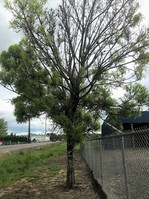
Photo: Even though this ash tree seems to show symptoms of EAB, no EAB has been detected. This tree was likely damaged by widespread spraying of herbicides in its root zone. Credit: UCF Library.
Please do not remove ash trees “pre-emptively.” Until we all know the spread of this insect, we are still reaping the many benefits of this tree along our streets and streambanks. As medium-large stature trees, ashes create broad canopy and cast great shade. Premature removal of these trees may not only result in depleting your city’s canopy, but also in your city’s eligibility to participate in future grant programs designed to help cities deal with this pest.
Finally, work with ODF-UCF staff to develop an EAB preparedness plan or, if EAB is already detected, a strategy for dealing with the pest. Stay informed as to where EAB is being detected. Below are links to newsletters, webpages, and program webinars that will keep you in touch. If you have questions, please contact us at urbanforestry@odf.oregon.gov.
|
|
|
Oct. 1-4, 2022
PNW-ISA Annual Training Conference
"Arborpalooza: Exploring the Wide World of Trees!"
Register
It’s been a long 2.5 years, but at last the PNW Chapter of the International Society of Arboriculture will be holding its Annual Training Conference (ATC) in-person in Coeur D’Alene, Idaho on Oct. 1-4!
The PNW-ISA’s ATC is one of the best places for arborists (and all tree-people) to network and gain the Continuing Education Units needed for arborist certification. This year, a new learning track on Women in Arboriculture is available. From the Tree Climbing Competition and Tree Academies (one on soil, the other on tree appraisal) on Saturday, to the Field Day on Sunday, to two days of conference programs, outdoor walks, and a trade show, this year’s ATC will not disappoint! PNW-ISA members and their families are encouraged to attend this year's event at the beautiful Coeur d'Alene Resort. View registration and hotel information. View the “flipping book” for this event, with registration pricing options, agendas and more!
Oct. 6, 2022
Restoring Ancestral Stewardship with Community & Our Urban Forests
Register
Co-hosted by University of Washington Botanic Gardens and PlantAmnesty, wǝɫǝbʔaltxʷ - Intellectual House, UW Seattle campus.
This year’s program aims to bridge the gap between tribal practices and local government, fostering the kinds of partnerships that can interweave community, access, ancestral stewardship, and current management practices that all work towards collaborative stewardship of our urban forests. Co-management of our urban forests is essential to their success, and we intend for this symposium to be an opportunity to harmonize community needs with policies that are consistent with Treaty Trust obligations, bringing together many different urban forestry interests and perspectives and finding a path forward.
Nov. 16-17, 2022
Partners in Community Forestry Conference
Register
The Partners in Community Forestry Conference is coming to Seattle Nov. 16-17! For urban forestry advocates and practitioners, this is one of the best events for learning and networking there is! Every year the conference is held somewhere in the USA, and this year it is almost in our backyard!
“The Partners in Community Forestry conference is the largest international gathering of urban forestry practitioners, advocates, researchers, and government leaders. At this year's conference in Seattle, Washington, you will be among fellow attendees who are passionate about all things trees — from planting and tending to the latest research.”
Along with the Partners conference, there are several “partnering” events held 1-2 days ahead of Partners, with additional costs. The Partners Conference website will give you additional information on the Alliance for Community Trees Day, Society of Municipal Arborists, the Urban Wood Network, and the Utility Arborist Association.
Dec. 15, 2022... is the deadline for Oregon’s Tree City USA, Tree Campus HE, and Tree Line USA applications!
See the article in this newsletter about preparing your application. Prospective Tree Cities and Tree Campuses – take the Readiness quizzes!
January – March 2023
Green Communities Leadership Institute coming next year!
Growing next level leaders for nature based solutions –applications open for 2023. Learn about the program.
|
|
Never let a crisis go to waste
Could there possibly be a bright side to statewide emerald ash borer (EAB) invasion? If EAB takes hold in Oregon the way it has in the upper Midwest and East Coast, many cities will be spending a lot in tree removal, disposal, and replanting. Especially in western Oregon, cities may lose between 5 percent and 10 percent of their urban tree canopy. This may not sound like a lot, but for many cities this equates to hundreds if not thousands of trees they will eventually need to remove and dispose of. Along our rivers and streams, where native ash is most at home, we will lose a key ecological player. In riparian areas, ash shade streams, hold stream banks with their roots, and provide food and habitat for birds and other wildlife.
Yet… there is an adage: Never let a crisis go to waste. This puts the onus on us all – individuals, city leaders, landowners and homeowners, and as state agency staff – to act decisively yet mindfully, share timely, accurate information, and learn from this situation. Here are a few potential benefits of this crisis:
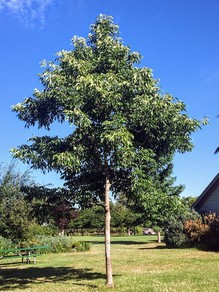
-
Heightened awareness of the benefits of urban trees and the commitment to maintain them. As the ashes disappear from our streets and parks, people will bemoan their loss as they did with the loss of the American elm. Our city trees are an important asset to our community livability, much like stoplights and paved roads. Like other community assets, routine maintenance, monitoring, and replacement and the financial commitment to support these activities are essential for reducing urban tree risks and enhancing tree values.
-
Cities creating and implementing urban forest management plans for the long-term health of their urban trees. Cities that already have comprehensive urban tree inventories will have a head start in planning and dealing with EAB-infested ashes compared to those that don’t. (See TPI article) Tree inventories help cities respond proactively, and as they replace their dying ashes, can augment their tree diversity. EAB will not be the last invasive insect that shows up in our urban forests, but it may spur many cities to plan for similar eventualities.
-
An increase in community tree planting efforts – Like the energy that went into organizing students and civic groups in planting trees after the Tillamook fires in the first half of the 20th Trees will need to be replaced in cities and along riparian areas. The need to create shade for stream species and all community dwellers – especially for fish and forest animals, and people in marginalized and low-canopied rural areas – will be greater than ever. This will be a great opportunity to build neigh-to-neighbor, and neighborhood-to-neighborhood connections.
-
Urban Wood utilization and the advancement of wood related technologies – One of the advantages of detecting EAB now, as opposed to 10 years ago, is that we can take advantage of what other cities have learned. The Lincoln Biochar project, for example, is exploring ways to make urban wood waste – including trees killed by EAB – into biochar.
|
|
|
TreePlotter™ Inventory – An important tool for preparing for invasive insects
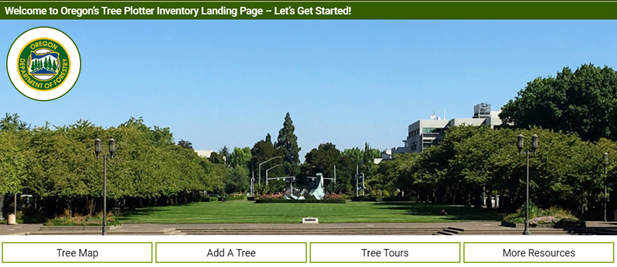 With the recent discovery of the destructive and invasive insect emerald ash borer (EAB) in Oregon there has never been a better time to inventory your city’s trees! A tree inventory can enable cities to query and determine where their ash trees are located and estimate the costs associated with treating, removing, and/or replacing them. Also, if the time comes, a tree inventory can help a city access FEMA and other federal relief funding to deal with the onslaught of this destructive pest! If your city does not have the resources to inventory all its public trees, it can focus its inventory efforts on simply locating and assessing just the ashes in town.
In part due to the EAB threat in Oregon, ODF’s U&CF Assistance program has just negotiated the continuation of the “all access” contract it has had with PlanIT Geo for the past three years. This means that the TreePlotter™ Inventory software will continue to be available for free for cities to use. The software is simple to learn and ash trees are relatively easy to identify so if you are interested in learning more, please get in touch.
The larger picture is that we are trying to build our statewide tree database by gathering tree inventory data – either through the use of TreePlotter™ Inventory or by importing other city tree inventory data into the software (via a “crosswalk”).The more we can learn about the location, number, size and condition of your city trees, in general, and ash trees, specifically, the more we can help cities prepare for the EAB. If your city has a tree inventory with other software and can share it with us either as a shapefile or as a CSV with latitude and longitude data, we can import it into the statewide database. If you have tree inventory data to share, please email urbanforestry@odf.oregon.gov. We are a bit short-staffed right now but will respond to you as quickly as possible.
|
|
Which tree has the poisonous leaves? Should I put a wound dressing on that pruning cut?
In this issue, we thought we would link you to an interesting website. Dr. Linda Chalker-Scott, with Washington State University Extension, has researched a bunch of horticultural myths, many of which pertain to tree care. View and read the results of her testing.
* BMP is short for “Best Management Practice(s).”
Timely tree tips: Tree owner’s manual
From Tree Link, Washington DNR Urban & Community Forestry News.
With hopes of increasing the number of healthy, long-lived landscape trees, many communities have created Tree Owner’s Manuals, or standards in care manuals. Just like any good owner’s manual that comes with automobiles and appliances, these booklets (or PDFs) provide straightforward instructions, useful tips, checklists for troubleshooting problems, and exceptionally clear illustrations. Learn about tree owner's manuals and to download your own copy!
Expand the breadth and depth of your tree knowledge!
Clackamas Community College offers an Associate of Applied Science Degree in its Landscape Management, Arboriculture Option program. In two years, you can learn the skills needed to perform aerial tree work, plant health care and tree diagnosis, as well as have the knowledge base to take the ISA Certified Arborist exam. Learn more about the program.
|
|

Tree City USA readiness quiz
There is a new tool to help more communities and higher education campuses assess their readiness to become a Tree City or Tree Campus. The tool provides summarized recommendations and automated follow-up. The Tree City USA Readiness Quiz and Tree Campus Higher Education Readiness Quiz are located at the top of the program webpages.
The application portals for all of these programs are available now. Before you start, gather the items you will need to make the completion of the application as streamlined as possible.
|
- A scanned copy (PDF) of your city’s/campus’ SIGNED and DATED current year Arbor Day proclamation.
- First and Last names of the members of your city/campus tree committee and the contact info for the committee chair/college contacts.
- Uploadable photos of your Arbor Day events and other tree-related events throughout the year. Tip: "medium" resolution photos (instead of high resolution) are best...
- Scanned copies (PDFs) of newspaper clips, event posters, social media, and/or (for cities) city council meeting minutes that describe the TCUSA/Tree Campus ceremony in your town/college.
- If your city/campus has undertaken a community tree student learning project during the calendar year, try to capture the number of volunteers/students that were involved. Also remember to track the time your tree committee members have come together. Tree Cities, remember volunteer hours can be counted towards your $2 per capita requirement.
- An uploadable copy of your city's community forestry annual plan for the upcoming year. Tree Campuses are required to upload a campus tree maintenance plan that should be updated at least every five years. Tree Campuses also need to report on how they have implemented the campus tree plan annually.
- Your city's/campus’ tree/urban forestry-related expenditures.
- If possible, info on the number of trees planted, pruned, and removed in your city/campus
- A list of the dates the city/campus tree committee/commission met during the current year.
If you have questions or concerns about applying for Tree City USA, please contact urbanforestry@odf.oregon.gov.
|
|
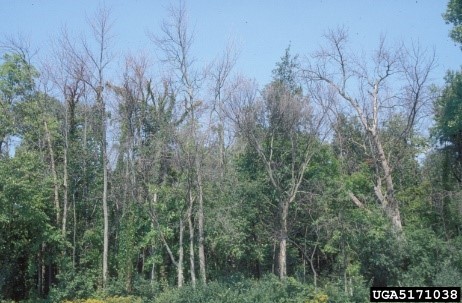 |
|
Emerald ash borer arrival in Oregon will bring changes to NW streams and urban forest
The long-anticipated arrival in Oregon this summer of the destructive emerald ash borer sharpens concerns about the impacts to urban forests, wetlands and streams.
Read more about the emerald ash borer.
|
|
|
Oregon Invasive Species Council launches digital information hub
The Oregon Invasive Species Council (OISC) has created an interactive tool to search, learn, compile and share available information for aggressive non-native species that pose a threat to Oregon’s environment, economy, or public health. Species profiles provide information about numerous species from various taxa groups. The profiles include recent and active alerts, species descriptions, introduction pathways and distributions. View the council's website.
Climate and Economic Justice Screening Tool
From Alliance for Community Trees.
CEQ Publishes Draft Climate and Economic Justice Screening Tool, Key Component in the Implementation of President Biden’s Justice40 Initiative | The White House the Biden Administration's Council on Environmental Quality just released the beta version of their Climate and Economic Justice Screening Tool. Find the tool here, and add it to your toolbelt to identify neighborhoods of greatest need in the communities you serve.
The Language of Trees: A Conversation with Alison Hawthorne Deming and Kathleen Dean Moore
On April 26 at 2 p.m. EDT, The Forest School at the Yale School of the Environment, Orion Magazine and the Yale Forum on Religion and Ecology present the third event in a series to celebrate Orion’s latest anthology, Old Growth. “The Language of Trees” will feature a conversation between Alison Hawthorne Deming, author of Zoologies: On Animals and the Human Spirit(link is external), and Kathleen Dean Moore, author of Earth’s Wild Music: Celebrating and Defending the Songs of the Natural World(link is external)...
Read more about "The Language of Trees: A Conversation with Alison Hawthorne Deming and Kathleen Dean Moore."
Urban Forest Connections webinars series
Monthly, Second Wednesdays, 1:00-2:15 p.m. (EDT)
USDA Forest Service
Free webinars offering continuing education credits. Discussions on the latest science, practice, and policy on urban forestry and the environment. Past webinars are recorded and available on their website.

TREE Fund webinar series
TREE Fund and the Alabama Cooperative Extension System
Free, webinars offering continuing education credits. Discussions on the latest in tree research. Past webinars are recorded and available on the webinar archive website. ISA Certified Arborists! Need a CEU for a past webinar that you missed attending? Watch the recorded webinar Loading of a Tie-in Point While Climbing and then complete the 20-question quiz with 80% accuracy!
|
|
|
“We and the Woods,” the Second Runner-Up in the 2022 Yale Environment 360 Film Contest, tells the story of an ascetic community in western Thailand whose residents have a deep connection to the forest and have banded together to protect their woodlands from logging, tourism projects, and other development.
* Credit to OPB's online newsletter and "Click of Zen" feature. Your “reward” for reading to the end of the newsletter.
|
|
Contact
Scott Altenhoff
Program Manager
503-945-7390
Email
|
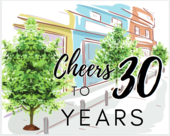 ODF's Urban and Community Forestry Assistance Program celebrated 30 years of service in 2021!
|
|
About the Community Tree Connections newsletter
Community Tree Connections (CTC) is a periodic publication by the Oregon Department of Forestry, Urban and Community Forestry Assistance Program. Our mission is to help Oregonians improve their quality of life by promoting community investment in our urban forests. CTC is published in cooperation with the USDA Forest Service. The USDA is an equal opportunity provider and employer. Subscriptions to Community Tree Connections are free. Sign up to receive the newsletter.
|
|
|
|
|